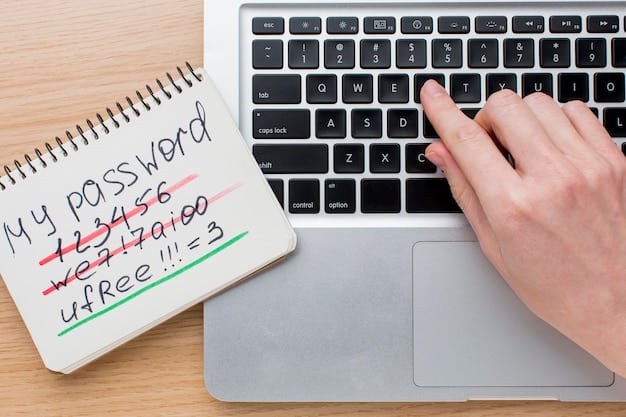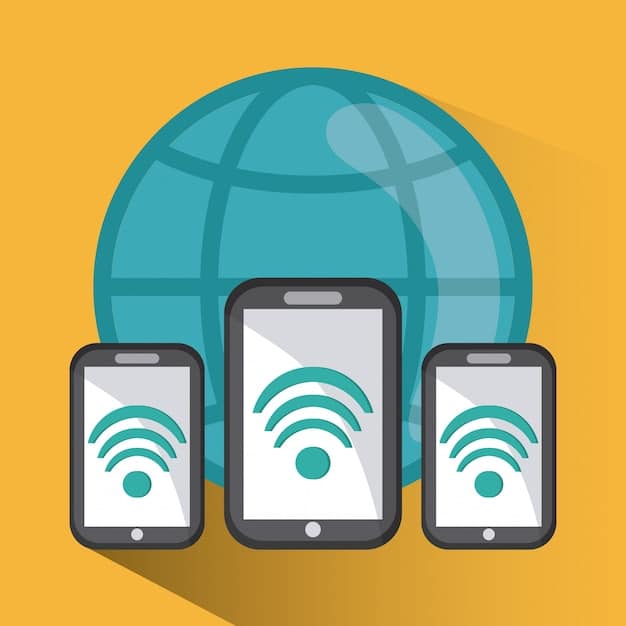Cybersecurity on the Road: Your 2025 Travel Protection Guide

Cybersecurity on the Road: A Traveler’s Guide to Protecting Your Devices in 2025 offers essential tips and strategies to safeguard your data while traveling, focusing on practical measures like using VPNs, securing devices, and staying vigilant against phishing attempts to ensure a safe and secure journey.
Traveling in 2025 means staying connected, but it also means facing increased cyber threats. Our Cybersecurity on the Road: A Traveler’s Guide to Protecting Your Devices in 2025 provides practical steps to ensure your digital safety during your journeys.
Planning for Secure Travel in 2025
As we approach 2025, travel is becoming increasingly reliant on digital devices. From booking flights and accommodations to navigating new cities, our smartphones, laptops, and tablets are indispensable. However, this dependence also makes us vulnerable to cyber threats.
Before embarking on any trip, it’s crucial to create a cybersecurity plan. This involves assessing your risk factors, understanding potential threats, and implementing preventative measures to protect your devices and data.
Assessing Your Cybersecurity Risk
Start by understanding your individual risk profile. Are you carrying sensitive work information? Do you access financial accounts on your devices? The more valuable your data, the greater the risk you face.
Understanding Potential Threats
Familiarize yourself with the common cybersecurity threats faced by travelers. These include public Wi-Fi vulnerabilities, phishing scams targeting travelers, malware infections, and physical device theft.
- 📶 Secure all devices with strong, unique passwords.
- 🛡️ Install and update antivirus software on all devices (phones, tablets, laptops).
- 🔑 Enable two-factor authentication (2FA) whenever possible. This adds an extra layer of security.
By taking these proactive steps, you can significantly reduce your risk and travel with greater peace of mind.
In conclusion, planning is paramount. By assessing your risks and understanding the potential threats, you can create a solid foundation for secure travel in 2025.
Securing Your Devices Before You Go
The security of your devices is the cornerstone of your cybersecurity strategy. Before you even pack your bags, take steps to ensure your smartphones, laptops, and tablets are protected.
Focus on strong passwords, software updates, and data backups to minimize potential damage from cyberattacks or device loss.

Strong Passwords and Password Managers
Use strong, unique passwords for all your accounts and devices. A password manager can help you create and store complex passwords without having to memorize them.
Software Updates and Antivirus
Ensure all your devices have the latest software updates and antivirus protection. Software updates often include critical security patches that protect against known vulnerabilities.
- 🔄 Regularly back up your data to a secure cloud service or external hard drive.
- 💻 Encrypt sensitive data on your devices when sending and receiving.
- 📱 Use remote wipe capabilities in case your device gets lost or stolen.
Securing your devices before you leave can prevent many common cybersecurity incidents. These steps can protect your data and ensure you have backups in case of theft or loss.
In conclusion, securing your devices before traveling ensures your digital safety. Strong passwords, updated software, and regular backups keep your sensitive information protected.
Using Public Wi-Fi Safely
Public Wi-Fi networks are convenient but notoriously insecure. They are often unencrypted, making it easy for cybercriminals to intercept your data. However, with the right precautions, you can use public Wi-Fi safely.
A Virtual Private Network (VPN) is your first line of defense. It encrypts your internet traffic, protecting it from eavesdropping. Always connect to a VPN before using public Wi-Fi.
What is a VPN and Why Use It?
A VPN creates a secure, encrypted connection between your device and a remote server. This disguises your IP address and protects your data from being intercepted.
Tips for Safe Public Wi-Fi Usage
Besides using a VPN, there are other steps you can take to protect yourself on public Wi-Fi. These include avoiding sensitive transactions, enabling HTTPS, and using a personal hotspot.

- 🚫 Avoid accessing sensitive information like bank accounts or credit card details on public Wi-Fi.
- ✅ Always ensure websites use HTTPS (indicated by a padlock icon in the address bar).
- 🔒 If possible, use your phone’s personal hotspot instead of public Wi-Fi.
By using a VPN and following these tips, you can minimize the risks associated with public Wi-Fi. Stay vigilant and prioritize your digital security while on the road.
In conclusion, utilizing public Wi-Fi requires caution. A VPN encrypts your connection, while avoiding sensitive transactions keeps your data safe from cyber threats.
Staying Vigilant Against Phishing Scams
Phishing scams are a common tactic used by cybercriminals to trick people into revealing sensitive information. These scams often target travelers with fake booking confirmations, urgent requests, or enticing offers.
Recognize phishing attempts by looking for suspicious emails, text messages, or phone calls. Verify the sender’s authenticity and avoid clicking on links or downloading attachments from unknown sources.
How to Identify Phishing Attempts
Phishing emails often contain poor grammar, spelling errors, and generic greetings. They may also create a sense of urgency to pressure you into taking immediate action.
Protecting Yourself from Phishing
Be skeptical of unsolicited messages and verify the sender’s identity before providing any personal information. Use anti-phishing tools and report suspicious activity to the appropriate authorities.
- 🧐 Always double-check the sender’s email address for legitimacy.
- 📞 Verify urgent requests by contacting the organization directly through official channels.
- 🖱️ Hover over links to preview the URL before clicking.
By staying vigilant and being aware of the signs of phishing, you can protect yourself from falling victim to these scams. Take your time, verify information, and trust your instincts.
In conclusion, vigilance is key against phishing attacks. Identifying suspicious messages and verifying sender identities can keep sensitive data safe.
Data Privacy and Local Regulations
When traveling internationally, it’s essential to be aware of local data privacy laws and regulations. Different countries have different rules regarding data collection, storage, and usage.
Familiarize yourself with the data privacy laws of your destination. Understand your rights and how your data may be handled by local businesses and government agencies.
Understanding Local Data Privacy Laws
Research the data privacy regulations of the countries you plan to visit. Some countries have strict laws protecting personal data, while others have more lenient policies.
Steps to Protect Your Data Abroad
Take steps to protect your data while traveling internationally. These include using privacy-focused apps, adjusting your social media settings, and being cautious about sharing personal information.
- 🌐 Use privacy-focused search engines and messaging apps.
- 🔒 Adjust your social media privacy settings to limit data sharing.
- ✍️ Be mindful of what you share online and in public forums.
By understanding local data privacy laws and taking proactive measures, you can protect your personal information while traveling abroad. Stay informed and prioritize your privacy.
In conclusion, knowing local data privacy laws is important. Using privacy-focused apps and being mindful of information shared protects your data abroad.
Physical Security of Your Devices
While cybersecurity focuses on digital threats, it’s equally important to consider the physical security of your devices. Theft or loss of your devices can expose your data to unauthorized access.
Keep your devices secure by using physical locks, keeping them in sight, and avoiding leaving them unattended in public places. Enable remote wipe capabilities in case of theft or loss.
Protecting Your Devices from Theft
Use device locks, cables, and other physical security measures to deter theft. Be aware of your surroundings and avoid leaving your devices unattended in public areas.
What to Do if Your Device is Lost or Stolen
If your device is lost or stolen, immediately report it to the local authorities and your service provider. Use remote wipe capabilities to erase your data and prevent unauthorized access.
- 🎒 Keep your devices in a secure bag or backpack.
- 👁️ Never leave your devices unattended in public places.
- 🚨 Report lost or stolen devices immediately to the authorities.
By prioritizing the physical security of your devices, you can reduce the risk of theft or loss and protect your data from unauthorized access. Stay vigilant and take preventative measures.
In conclusion, securing your devices physically is essential. Keep them in sight and utilize remote wipe capabilities to protect against theft or loss.
Staying Updated on Cybersecurity Trends
The cybersecurity landscape is constantly evolving, with new threats and vulnerabilities emerging all the time. Staying informed about the latest trends and best practices is crucial for maintaining your digital security.
Follow cybersecurity news sources, subscribe to industry newsletters, and attend webinars or conferences to stay up-to-date on the latest threats and defense strategies.
Following Cybersecurity News and Updates
Stay informed about the latest cybersecurity threats and vulnerabilities by following reputable news sources, blogs, and social media accounts.
Implementing Best Practices
Regularly review and update your cybersecurity policies and procedures to reflect the latest best practices. Implement multi-factor authentication, conduct regular security audits, and train your employees on cybersecurity awareness.
- 📰 Subscribe to cybersecurity newsletters and blogs.
- 🌐 Follow industry experts on social media.
- 📚 Attend cybersecurity webinars and conferences.
By staying updated on cybersecurity trends and implementing best practices, you can continuously improve your defenses and protect yourself against emerging threats. Make cybersecurity a priority and stay informed.
In conclusion, staying updated on cybersecurity trends is crucial. Following news sources and implementing best practices ensures continual defense against emerging threats.
| Key Point | Brief Description |
|---|---|
| 🔑 Strong Passwords | Use unique, complex passwords for all accounts. |
| 🛡️ VPN Usage | Encrypt your connection on public Wi-Fi networks. |
| 🧐 Phishing Awareness | Recognize and avoid suspicious emails and links. |
| 📱 Physical Security | Keep devices secure to prevent theft or loss. |
FAQ
▼
The biggest risk is using unsecured public Wi-Fi. Cybercriminals can intercept your data on these networks, including passwords and financial information.
▼
Install and regularly update antivirus software on all devices. Also, be cautious about downloading files or clicking on links from unknown sources.
▼
Report the theft to local authorities and your service provider immediately. Use remote wipe capabilities to erase your data to prevent unauthorized access.
▼
Look for poor grammar, spelling errors, and generic greetings. Be skeptical of urgent requests and verify the sender’s identity before providing information.
▼
Public charging stations can be risky due to potential “juice jacking” attacks. Use your own charger and power bank whenever possible to avoid data compromise.
Conclusion
In conclusion, traveling in 2025 requires a proactive approach to cybersecurity. By implementing these tips, remaining vigilant, and staying informed, you can protect your devices and data while enjoying your journeys. Safe travels!





